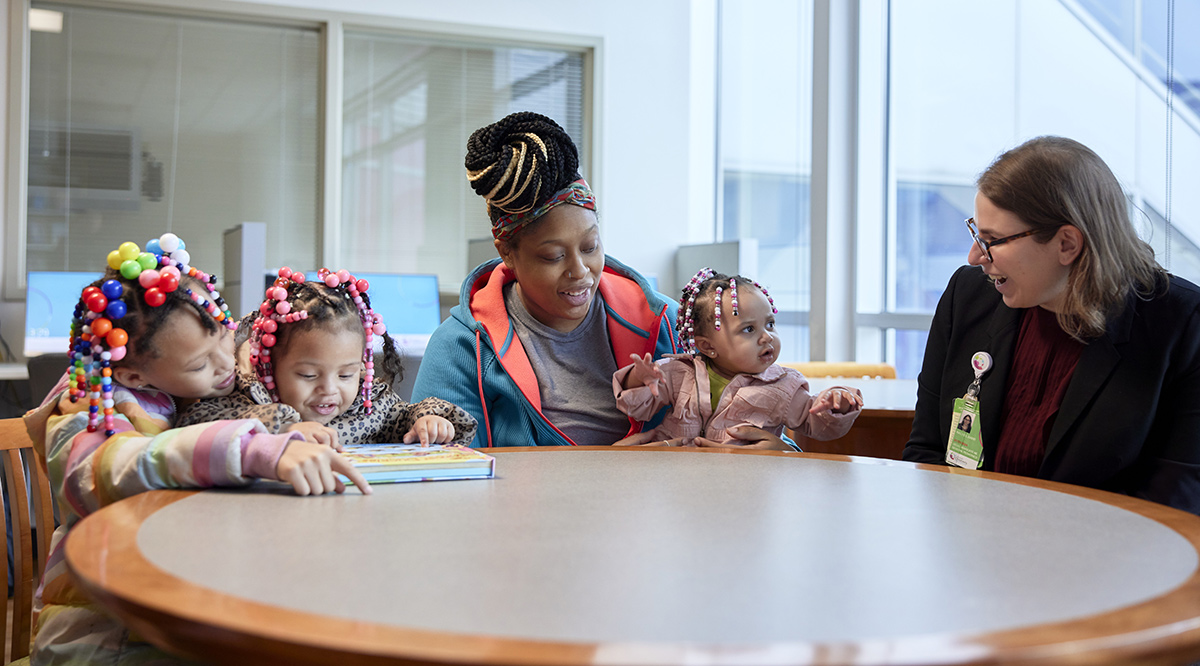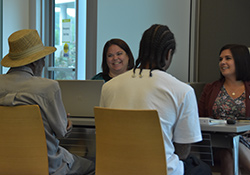
For two years, Tanikkia Steele fought with her son’s school to get his needs met. D*, then a Cincinnati middle-schooler, was suffering from ADHD, depression, and other mental health issues. His grades were dropping, and his behavioral problems were rising.
But Steele was getting nowhere — until she shared her frustration with a doctor at Cincinnati Children’s Hospital.
“He said, ‘I’m going to put you in touch with a lawyer and get the resources your son needs to be successful,’” she recalls.
Soon, staff at the Cincinnati Child Health-Law Partnership (Child HeLP) were preparing paperwork, accompanying Steele to school meetings, and ensuring the creation of an appropriate educational plan.
Today, D is doing better academically and emotionally — and he’s even on his high school football team, Steele says proudly.
“I had been so frustrated. My cries for help were going unheard until the lawyer stepped in,” says Steele. “We would never be where we are today without her.”
Each year, tens of thousands of families like the Steeles get help from medical-legal partnerships (MLPs) across the United States. These programs integrate legal experts into clinic and hospital care teams to help patients and their families address social determinants of health through legal action.
Specifically, MLPs work to prevent evictions, enforce workers’ rights, appeal public assistance denials, and press landlords to address pest infestations and other noxious living conditions, among other law-related efforts.
“These days, there’s a lot of activity in medicine around screening patients for social needs. Unfortunately, though, often there’s nothing a doctor can do to address those needs,” says Philip Alberti, PhD, director of the AAMC Center for Health Justice. “But a lawyer sometimes can.”
Often, MLP patients don’t know they have a particular legal right — the right to appeal a denial of public assistance, for example — or can’t imagine acting on it. In fact, 81% of low-income individuals receive no help for their civil legal problems, according to a 2021 nationwide survey. So MLPs work to simplify the process, identifying needs during medical appointments and ensuring quick connection to legal guidance.
“I had been so frustrated. My cries for help were going unheard until the lawyer stepped in. We would never be where we are today without her.”
Tanikkia Steele
The growth of MLPs has been impressive. A decade after the first one was born in 1993 — after Boston Medical Center doctors discovered that many asthma patients lived in substandard housing — there were roughly 75. Today, there are more than 450-plus, according to the National Center for Medical-Legal Partnership, a nonprofit that spearheads MLP education, research, and technical assistance efforts.
Research supporting the approach is also increasing. In fact, President Biden has called MLPs an “innovative and evidence-based solution for access to justice.”
But given a patchwork of funding sources, leaders worry whether MLPs will be able to serve all those who need the service.
Eileen Moore, MD, medical director of the Health Justice Alliance at Georgetown University and an internist at MedStar Health in Washington, D.C., certainly hopes the model continues to grow.
“Before our MLP, I would often feel powerless because my toolbox for helping patients was only so big,” she says. “Having an MLP has been life-changing to my practice.”
Unmet legal needs
Medical care accounts for a slim portion of a person’s health — perhaps 20% — research suggests. Much of the rest flows from such social factors as healthy housing, reliable work, and safe relationships — all of which can require legal action to achieve.
Individuals living in poverty often face several legal problems at once, according to the nonprofit Legal Services Corporation. In 2021, more than 60% of low-income individuals experienced two or more civil legal problems.
Yet these individuals rarely access legal assistance — or may hold off until their situation grows dire, with the looming possibility of losing a home, a job, or child custody.
Lower-income individuals may not seek legal help for numerous reasons, including not knowing that their rights have been breached, experts say.
“A patient who isn’t getting work accommodations may think they just have a problem with their boss, when what they really have is a legal problem because their boss is breaking the law,” says Kerry Rodabaugh, MD, medical director of the MLP at Nebraska Medicine in Omaha.
Sometimes, patients would like to avoid a legal system they don’t trust. “A lot of our patients have had bad experiences with the law,” says Moore. “I often don’t even use the word ‘lawyer’ because it can be triggering. Instead, I say, ‘My partner from the legal team.’”
But health care providers are often well-positioned to help patients get the legal assistance they need. For one, they are already trained in screening skills, and they often discuss related issues such as a patient’s ability to obtain healthy food.
Providers also often have patients’ trust. “We have long-term relationships with our patients. This is a trustworthy place for them. We can say, ‘This [legal assistance] is part of your doctor’s plan for your care,’” notes Anna Kirkman, JD, director of the MLP at Eskenazi Health in Indianapolis.
“A lot of our patients have had bad experiences with the law. I often don’t even use the word ‘lawyer’ because it can be triggering. Instead, I say, ‘My partner from the legal team.’”
Eileen Moore, MD
Medical director, Health Justice Alliance at Georgetown University
Ultimately, the legal connection can provide crucial support to doctors faced with frustrating — even heartbreaking — situations.
“As a gynecological oncologist, I’ve treated many terminal patients,” Rodabaugh explains. “I would sometimes see single mothers who worried a great deal about custody of their kids. They would ask me, ‘What will happen to my children when I’m gone?’ I wanted to give them some peace, but I had no answer. That’s why I began my work with MLPs.”
MLPs step in
Often, patients get introduced to the MLP through a few basic — yet crucial — questions from their provider: Are you worried about your housing? Have you been unable to get public assistance like food stamps? Do you feel safe in your relationships?
These questions may be asked in a number of situations, perhaps as part of an annual physical, as a section on medical intake forms, or in a meeting with a hospital social worker, for example.

At some institutions, MLP referrals are built directly into patients’ electronic health records. “[The providers] just fill in the legal section, briefly describe the need, and mark it urgent or not. It automatically goes into the MLP work queue, which the legal team monitors, and then they start determining next steps,” says Kirkman, whose program serves 15 clinical sites.
Once in an MLP’s system, the legal team — perhaps legal aid staff, a pro bono lawyer, or a faculty member connected with an institution’s law school — contacts the patient. The connection may be immediate if the legal team is co-located, or it may take just a couple of days for those situated off-site.
Legal support can be fairly simple, such as exploring denied public benefits. “It might just take a lawyer’s phone call to an agency to straighten it out, and patients may even win retroactive payment. That could mean hundreds or thousands of dollars in the pocket of a family that really needs it,” says Andrew Beck, MD, a pediatrician who works with Cincinnati’s Child HeLP.
Sometimes, legal action necessitates months of work and may require a doctor’s input, such as a letter describing the medical condition that’s driving the legal need.
The type of aid provided also may reflect a population’s particular needs. At Eskenazi’s Gender Health Clinic, for example, lawyers often work to officially change a transgender patient’s name or gender marker on their driver’s license and other documents.
Elsewhere, patients experiencing domestic violence may need help obtaining a restraining order, and pregnant workers may need assistance getting an employer to provide breaks for necessary rest.
Often, participants say, the results are life-changing.
Cindy Calhoun, 67, recalls her relief at receiving MLP support for her 31-year-old son, whose schizophrenia symptoms had left him homeless, gravely ill, and disconnected from family members.
After he was hospitalized with malnutrition and wounds from an assault, the MLP team helped Calhoun gain legal guardianship of her son. That meant she could work with hospital social workers to secure Social Security disability coverage, supportive housing, and other benefits for him. “His life has completely turned around now,” she says.
What lies ahead?
MLP leaders are hoping to expand the reach of their programs in numerous ways.
Often, limited resources mean MLPs work in the handful of departments, like pediatrics, that seem most likely to benefit from addressing social determinants of health. At Nebraska, the MLP has now grown to five hospital departments — including the neonatal ICU and the emergency department — but Rodabaugh aims for even more. “Ultimately, the goal is to provide the service to every patient who needs it,” she says.
Educators also hope to increase the number of medical students and residents exposed to the model.
“The next generation needs to understand the crucial role of law in promoting health,” says Moore, who leads several legal education efforts at Georgetown’s School of Medicine. There, all students get MLP experience during clinical rotations, and a dozen fourth-year students spend a month working on legal issues alongside their law-school peers. “This adds a whole new dimension to their education,” says Moore.
Another potential MLP growth area lies in reaching beyond individual patients to the surrounding community.
In Cincinnati, for example, the team extended their scope several years ago after noticing that many asthma patients came from housing owned by one delinquent landlord. Legal advocates helped form a tenants’ association, filed necessary motions, and met with City Council members, ultimately winning dozens of residents healthier housing through repairs or relocation.
“Ultimately, the goal is to provide the service to every patient who needs it.”
Kerry Rodabaugh, MD
Nebraska Medicine
Meanwhile, some MLP efforts focus on expanding research on the model’s efficacy.
In one major effort, Beck and his colleagues compared more than 2,200 pediatric MLP patients with a control group using statistical modeling. In a 2022 paper, they reported significant results: the median hospitalization rate for MLP patients was almost 40% lower in the 12 months following a referral.
Another study reported a 319% return on MLP investment by recovering dollars for services the hospital could not receive reimbursement for until the MLP helped low-income patients gain insurance coverage.
More robust research lies ahead, says Joel Teitelbaum, JD, LLM, co-director of the National Center for Medical-Legal Partnership. That’s due in part to a major Center project that’s helping launch MLPs at Kaiser Permanente sites in six geographic regions. “This is the first time we are working with a national payer/provider to create MLPs. And they’re not just building MLPs but investing in the research to identify what really works,” he says.
MLP leaders hope positive research results can help win crucial funding for their efforts. Support now mostly comes from grants, philanthropic contributions, and hospital budgets. Those involved would like to see a steadier source of income, such as coverage of services through Medicaid.
Steele says she certainly hopes the model continues to thrive.
“This is a great benefit to any person going through a tough situation,” she says. “[My lawyer] not only used the law to help me, she also taught me about my rights and how to be heard about them. … I love her for sparking that fire in me.”
*Steele requested that AAMCNews refer to her son by his first initial only to protect his privacy.
